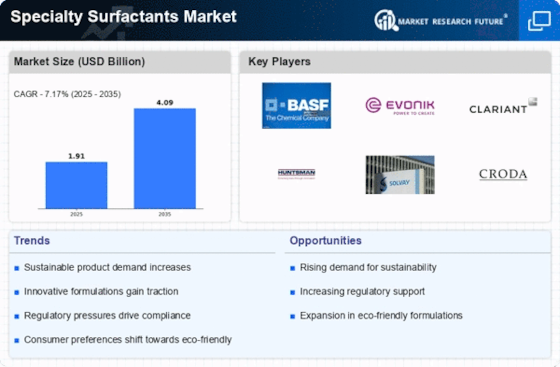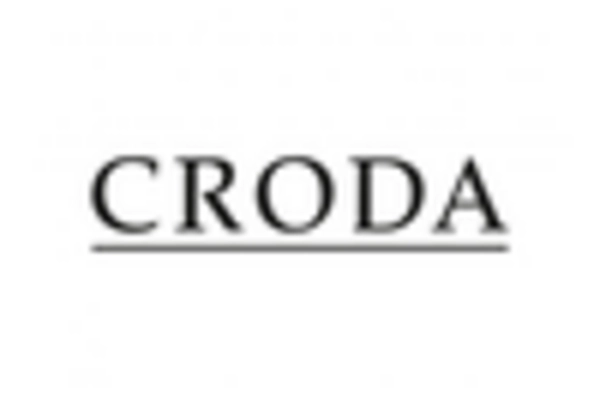Advancements in Biotechnology
The Specialty Surfactants Bio Surfactants Market is significantly influenced by advancements in biotechnology. Innovations in microbial fermentation and enzyme technology have enabled the production of bio surfactants that are not only effective but also cost-competitive. These biotechnological advancements facilitate the development of new formulations that meet diverse consumer needs across various applications, including personal care, household cleaning, and industrial uses. The market for bio surfactants is expected to expand as these technologies become more accessible and affordable. Furthermore, the integration of biotechnology in surfactant production may lead to enhanced performance characteristics, thereby attracting more industries to adopt bio-based alternatives. This trend indicates a promising future for the Specialty Surfactants Bio Surfactants Market as it embraces cutting-edge technologies.
Growth in Industrial Applications
The Specialty Surfactants Bio Surfactants Market is also experiencing growth in industrial applications, particularly in sectors such as agriculture, oil recovery, and cleaning products. Bio surfactants are increasingly recognized for their effectiveness in enhancing the performance of industrial processes, such as soil remediation and enhanced oil recovery. The ability of bio surfactants to reduce surface tension and improve emulsification properties makes them valuable in various industrial applications. Market forecasts suggest that the industrial segment will continue to expand, driven by the need for sustainable and efficient solutions. This growth reflects a broader trend within the Specialty Surfactants Bio Surfactants Market, as industries seek to adopt more environmentally responsible practices.
Rising Demand in Personal Care and Cosmetics
The Specialty Surfactants Bio Surfactants Market is witnessing a surge in demand from the personal care and cosmetics sector. Consumers are increasingly seeking products that are not only effective but also environmentally friendly. Bio surfactants, known for their mildness and biodegradability, are becoming preferred choices for formulations in shampoos, lotions, and other personal care items. Market data reveals that the personal care segment is expected to account for a substantial share of the bio surfactants market, driven by consumer preferences for natural ingredients. This trend indicates a shift in the Specialty Surfactants Bio Surfactants Market, as manufacturers adapt their product lines to meet the growing demand for sustainable personal care solutions.
Regulatory Incentives for Sustainable Products
The Specialty Surfactants Bio Surfactants Market is benefiting from an increasing number of regulatory incentives aimed at promoting sustainable products. Governments worldwide are implementing policies that encourage the use of bio-based materials, which in turn supports the growth of bio surfactants. These regulations often include tax breaks, subsidies, and grants for companies that invest in sustainable practices. As a result, manufacturers are more inclined to transition from traditional surfactants to bio-based alternatives, which are often viewed as more compliant with environmental standards. Market analysis suggests that the regulatory landscape will continue to evolve, further bolstering the Specialty Surfactants Bio Surfactants Market as companies seek to align with governmental sustainability goals.
Increasing Consumer Awareness of Sustainability
The Specialty Surfactants Bio Surfactants Market is experiencing a notable shift as consumers become increasingly aware of sustainability issues. This heightened awareness drives demand for eco-friendly products, prompting manufacturers to innovate and reformulate their offerings. As consumers seek products that align with their values, companies are compelled to invest in bio-based surfactants, which are perceived as safer and more environmentally friendly. Market data indicates that the demand for bio-based surfactants is projected to grow at a compound annual growth rate of over 5% in the coming years. This trend suggests that consumer preferences are reshaping the landscape of the Specialty Surfactants Bio Surfactants Market, pushing companies to adopt sustainable practices and enhance their product portfolios.



 Source: Primary Research, Secondary Research, MRFR Database and Analyst Review
Source: Primary Research, Secondary Research, MRFR Database and Analyst Review













Leave a Comment